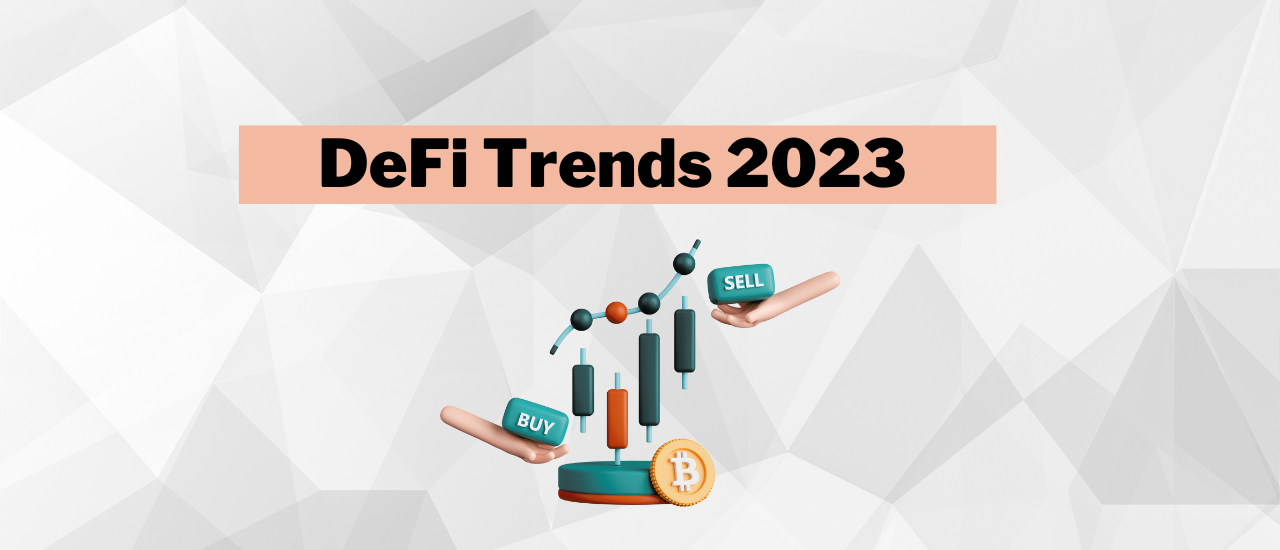
Best DeFi Trends To Know In 2023
Introduction
DeFi, a fintech system backed by a distributed ledger, enables financial transactions without the intervention of centralized financial institutions. As a result, DeFi employs blockchain technology to make financial resources open to anyone.
Furthermore, the system uses hack-proof software to link buyers, sellers, lenders, and borrowers with peers or an intermediary. Automation, higher security y, better integration, and increased transparency are some well-known benefits of DeFi in the banking business.
DeFi Trends to Watch in 2023
Staking and Mining for Liquidity
Liquidity mining, also known as yield farming, is the most recent protocol to be added to the DeFi protocol list. By lending tokens and assets to a decentralized exchange, crypto holders can receive incentives. The DeFi system allows users to facilitate trade for others on the network by lending their crypto assets.
It is rewarded with a fee/service charge or fresh cryptocurrency tokens. Staking is a reward-driven procedure in which people hold/lock up their crypto assets on the platform in order to get incentives (additional Bitcoin) and earn interest. It offers an extra possibility to earn from your Bitcoin holdings on the Decentralized Finance (DeFi) platform.
Cross-chain Technologies
One of the most recent expressions of the DeFi movement is cross-chain technology. It enhances interoperability between two independent blockchain networks, allowing for more efficient information sharing. Matic, India's blockchain scalability platform, also known as "Ethereum's Internet of Blockchain," is a significant effort to distribute the DeFi sector's load over many blockchain networks, speed up transactions, and enhance overall user experience. It is a great example of cross-chain technology, as well as a solution for delayed transactions and restricted scalability.
Blockchain Development
Blockchain technology continues to improve the efficiency of digital transactions through increased transparency and security enabled by decentralization. DeFi does this through the use of Ethereum, a well-known blockchain network recognized for simplifying/improving data security in international payments, digital currency, fintech applications, and smart contracts.
Decentralized Finance (DeFi) Gaming
As the number of players grows, the blockchain gaming sector is experiencing enormous DeFi growth. Blockchain gaming allows players to mine Bitcoin, non-fungible tokens (NFTs), and other intangible assets while playing. When it comes to commercializing the gaming business,
DeFi protocols can aid in guaranteeing in-game transferability. BitSport, the crypto gaming platform, has made it possible for cryptocurrency owners to support game contests. Such rivals and more gaming platforms will very certainly develop in popularity, making DeFi gaming one of the top DeFi ideas because it will almost certainly set a precedent by monetizing the gaming business.
Stablecoins
Stablecoins are cryptocurrencies whose market value is digitally linked to another currency, such as the US dollar. They are a different type of token in the DeFi network, developed to ensure that the Tokens' market value remains stable. Stablecoins are more secure and have lower transaction fees.
They can reduce cryptocurrency market volatility since they are linked to a physical object and take on the asset's market value. As a result, DeFi platform consumers may avoid market instability and have a more safe trading experience.
NFT Platforms
Non-fungible Tokens have cleared the way for the growth of the new digital economy by increasing the frequency with which content creators, merchants, and service providers visit NFT platforms like Opensea and Mintable.
NFTs raise a host of potential blockchain uses in addition to art and digital objects. The music industry was among the first to use NFTs when performers began tokenizing their tunes and selling them straight to their fans. NFTs also enable automated payments to record labels, musicians, managers, and other players in the music industry.
Governance Tokens
Individuals can use governance tokens to vote on blockchain project development and management issues. It is feasible to verify that the goals/interests of token holders are the same or comparable by having the ability to have a voice in blockchain project operations.
A DeFi project like Compound, for example, allows users to use native tokens for various farm or rent revenue schemes. It has its own Token (COMP), which oversees the expansion of the Compound DeFi protocol.
Metaverse
The creation of new social networks by artists and followers will soon be seen. In the Metaverse, a new immersive fan economy powered by social tokens has the potential to revolutionize digital commercialization. Using social tokens, communities or celebrities may further monetize their brand.
They will foster bidirectional interactions between artists and customers that will benefit both parties. Individuals, rather than organizations, become creative actors in a distributed collaborative paradigm. It is a unified and connected metaverse in which tokenized NFTs may include digital data rights and store, track, and enforce those rights.
Final Words
Blockchain is one of today's most advanced digital technologies. It provides more security, transparency, data integrity, and accessibility than traditional networks. Every day, the deployment of Blockchain technology via DeFi and NFTs transforms the finance business.
And as DeFi technology advances in the financial business, the following years will be more profitable. The development of NFTs, blockchain, and other cryptos (such as Stablecoins) will propel this decentralization concept to new heights and www.esrotlabs.com is the ultimate web3.0 development agency for you to bring ideas to life.
